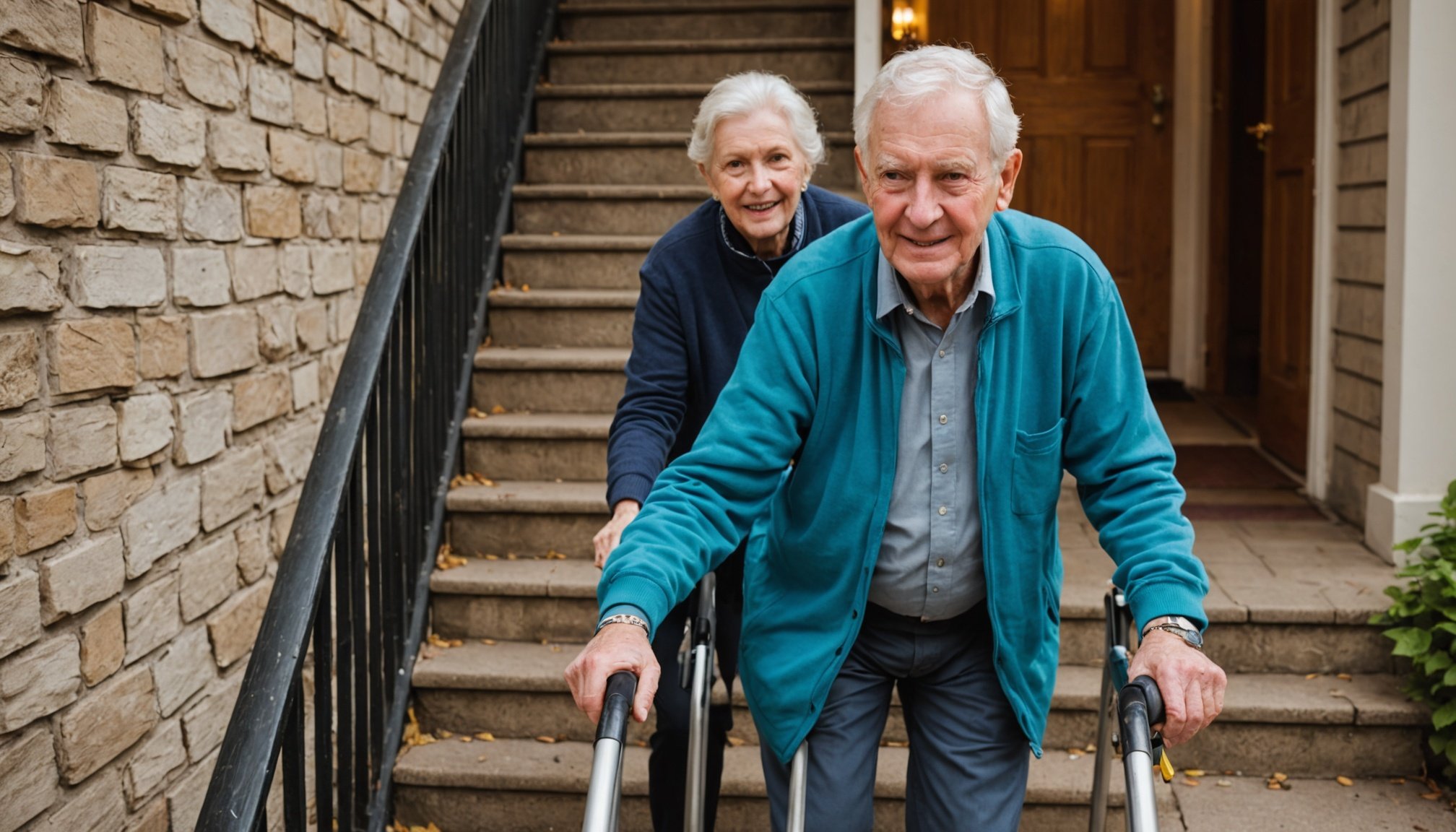Stair safety is vital for seniors, as missteps can lead to serious injuries. Understanding how to approach stairs with confidence can enhance mobility and independence. This guide offers practical tips to help seniors navigate stairs safely, from the right techniques for ascending and descending to the importance of proper footwear. Equip yourself with knowledge that empowers your daily routine and fosters a sense of security in your environment. Let's explore how simple adjustments can make all the difference in maintaining stability and confidence on stairs.
Understanding Stair Navigation Challenges for Seniors
Navigating stairs can present significant mobility challenges for seniors, leading to potential safety concerns. Recognizing these challenges is crucial for ensuring stair safety.
This might interest you : Effective Approaches for Enhancing COPD Management in Older Adults
Common Mobility Challenges
Many seniors experience reduced balance and coordination, making stair navigation difficult. Muscle weakness and joint pain can further exacerbate these issues, increasing the risk of falls. It is essential to understand these limitations to implement effective solutions.
Statistics on Falls and Injuries
Falls on stairs are a leading cause of injury among seniors. According to recent studies, one in four seniors falls each year, with a significant portion occurring on stairs. These incidents often result in severe injuries, highlighting the need for increased awareness and preventive measures.
Topic to read : Essential Heat Safety Guidelines for Seniors: Staying Safe During Extreme Temperatures
Recognizing Personal Limitations
Seniors must acknowledge their personal limitations when using stairs. This involves assessing physical abilities and adapting to changes over time. Additionally, environmental factors such as poor lighting or uneven steps can further complicate stair navigation.
- Stair safety tips:
- Install handrails on both sides of the staircase.
- Ensure adequate lighting to improve visibility.
- Use non-slip treads to prevent slipping.
Understanding these mobility challenges and taking proactive steps can significantly enhance stair safety for seniors, reducing the risk of falls and injuries.
Essential Tips for Safe Stair Navigation
Navigating stairs can be daunting for seniors, but employing effective strategies can promote safety and confidence.
Utilizing Handrails Effectively
Handrails are essential for safe stair navigation. Always use them to maintain balance and support. Install handrails on both sides of the staircase if possible. Ensure they are sturdy and at a comfortable height. Regularly check for any looseness or damage, as these can compromise safety.
Footwear Recommendations
Choosing the right footwear is crucial for fall prevention. Opt for shoes with non-slip soles and a secure fit. Avoid footwear with high heels or slippery soles, as they can increase the risk of falls. Comfortable, supportive shoes enhance stability, making stair navigation safer for seniors.
Techniques for Ascending and Descending Stairs
Adopting proper techniques for stair movement is vital. When ascending, step up with the stronger leg first. When descending, lead with the weaker leg. This method helps maintain balance and reduces strain on weaker muscles. Take one step at a time, and avoid rushing to prevent accidents.
- Tips for Safe Stair Navigation:
- Use handrails consistently
- Wear appropriate footwear
- Practice proper stair techniques
Implementing these strategies can significantly enhance safe stair navigation for seniors, reducing the risk of falls and injuries.
Safety Aids and Modifications for Stairways
Enhancing stair safety involves strategic use of aids and modifications to create a safer environment for seniors.
Overview of Safety Aids
Stairlifts provide an effective solution for those with severe mobility issues. They allow users to navigate stairs effortlessly, minimizing the risk of falls. Non-slip treads are another essential aid, reducing slipping hazards on stair surfaces. These can be easily installed on existing steps, offering a quick and cost-effective improvement.
Home Modification Tips
Home modifications can significantly enhance accessibility. Consider widening staircases where possible to provide more space for movement. Installing handrails on both sides of the staircase is crucial for added stability. For additional safety, ensure that each step has a consistent height and depth to prevent tripping.
Utilizing Lighting and Visual Cues
Proper lighting is key to improving stair navigation. Install bright, evenly distributed lighting to eliminate shadows and enhance visibility. Use contrasting colors or bright tape on stair edges as visual cues to help seniors identify each step clearly.
- Key Modifications:
- Install stairlifts for severe mobility challenges
- Use non-slip treads for added grip
- Ensure adequate lighting for improved visibility
Implementing these stair safety aids and modifications can greatly enhance the safety and accessibility of stairways for seniors.
Maintaining Independence in Stair Navigation
Empowering seniors with confidence and mobility assistance is crucial for maintaining independence.
Building Confidence Through Practice
Regular practice is vital for seniors to build confidence in stair navigation. By gradually increasing the frequency and complexity of stair activities, seniors can enhance their mobility skills. Encouraging a routine that includes safe stair exercises can foster a sense of achievement and independence.
- Key Practice Tips:
- Start with short sessions
- Focus on balance and coordination
- Celebrate small milestones
Seeking Assistance When Needed
Recognizing the need for assistance is important in maintaining independence. Seniors should be encouraged to ask for help when facing difficulties with stair navigation. Mobility aids like handrails or stairlifts can provide necessary support. Family members and caregivers play a crucial role in offering timely assistance and ensuring safety.
Community Resources for Support
Community programs and services offer valuable support to seniors striving for independence. Local organizations often provide resources such as mobility workshops and confidence-building activities. These programs can connect seniors with peers and professionals, fostering a supportive environment.
By leveraging these resources, seniors can enhance their independence and navigate stairs with greater confidence.
Expert Recommendations and Resources
Empowering seniors with expert advice and resources for safety and independence.
Recommendations from Occupational Therapists and Geriatric Specialists
Occupational therapists and geriatric specialists emphasize the importance of personalized approaches to enhance senior safety. They recommend regular assessments to tailor strategies that address individual needs. These experts often suggest incorporating mobility aids like handrails and stairlifts to minimize fall risks. Additionally, they advocate for exercises that improve balance and coordination, crucial for safe stair navigation.
Overview of Fall Prevention Programs and Resources
Fall prevention programs provide comprehensive support for seniors. These programs often include workshops on fall prevention techniques, offering practical advice on safety resources. Participants can learn about the latest mobility aids and home modifications to improve stair safety. These programs also foster community connections, helping seniors build a support network.
Contact Information for Local Organizations Offering Assistance
Local organizations are invaluable in delivering senior safety resources. They offer various services, from home safety assessments to fall prevention workshops. Contacting these organizations can provide seniors with access to personalized guidance and support.
- Key Organizations:
- Senior Safety Council
- Local Health Departments
- Community Centers
Utilizing these expert recommendations and resources empowers seniors to navigate stairs safely and maintain their independence.











